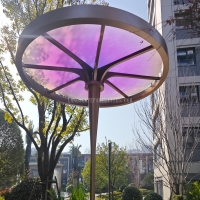Welcome to the website for landscape facilities products and knowledge.
How does the design prevent the buildup of grime in high-humidity areas?
In high-humidity environments like bathrooms, kitchens, and laundry rooms, grime buildup is a common challenge. However, modern design solutions effectively combat this issue through a combination of material selection, structural features, and maintenance-friendly layouts.
1. Material Innovation: Surfaces in high-humidity zones often incorporate non-porous, moisture-resistant materials like quartz, ceramic, or treated stainless steel. These materials repel water and resist microbial growth, reducing grime accumulation. Anti-microbial coatings further inhibit mold and bacteria.
2. Sloped Surfaces & Seamless Joints: Designers minimize flat, stagnant areas where water can pool. Sloped countertops, curved edges, and seamless silicone joints prevent moisture traps, making cleaning effortless.
3. Enhanced Ventilation Integration: Built-in ventilation systems, such as concealed exhaust fans or passive airflow channels, reduce condensation—a primary contributor to grime. Some designs even incorporate moisture-wicking wall panels.
4. Easy-Clean Textures: Smooth, glossy finishes or nano-coated tiles prevent dirt adhesion, while strategic textures (e.g., linear grooves) guide water runoff without trapping debris.
5. Modular Replaceability: High-wear components like shower trays or sink surrounds are designed for quick replacement, preventing long-term degradation that harbors grime.
By prioritizing these elements, modern spaces maintain hygiene and aesthetics despite humidity challenges—proving that prevention is the ultimate cleaning strategy.
Related search:

Recommendation
Metal frame with gradient color acrylic combined with high-end shading landscape facilities